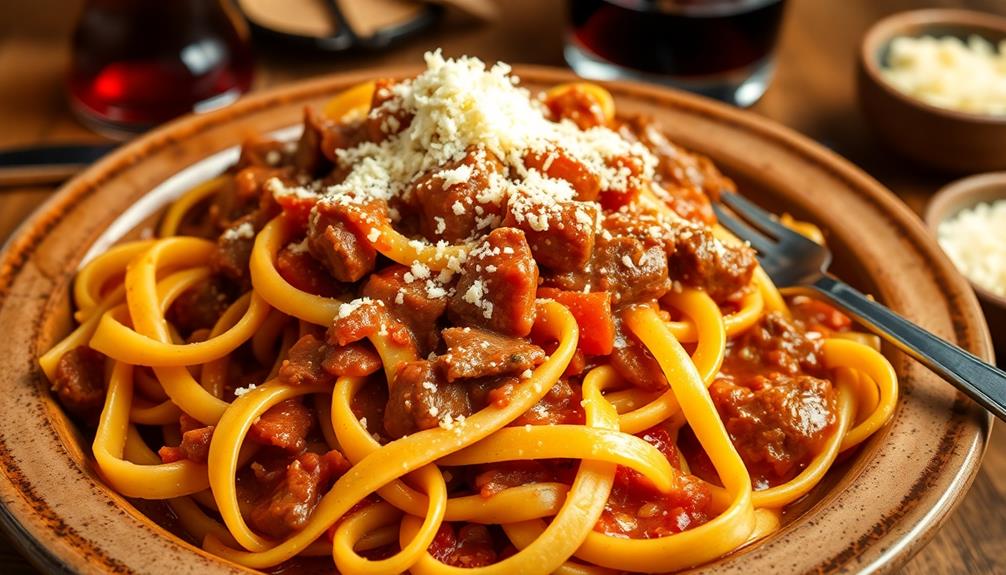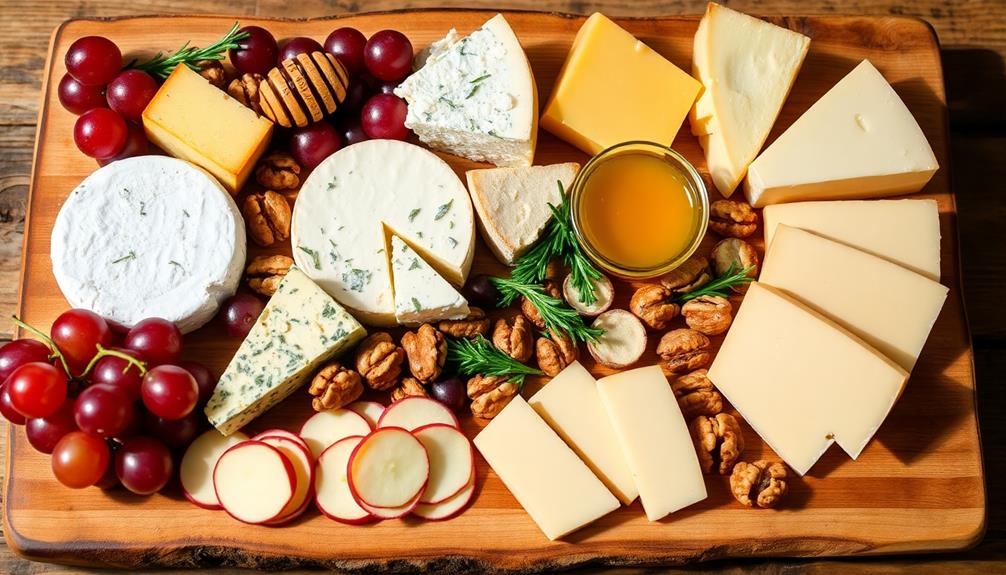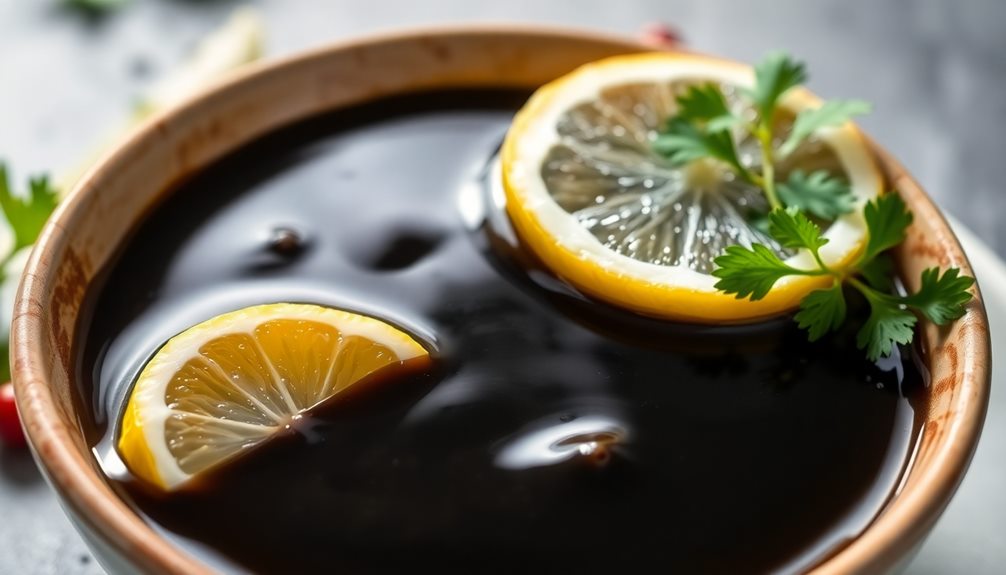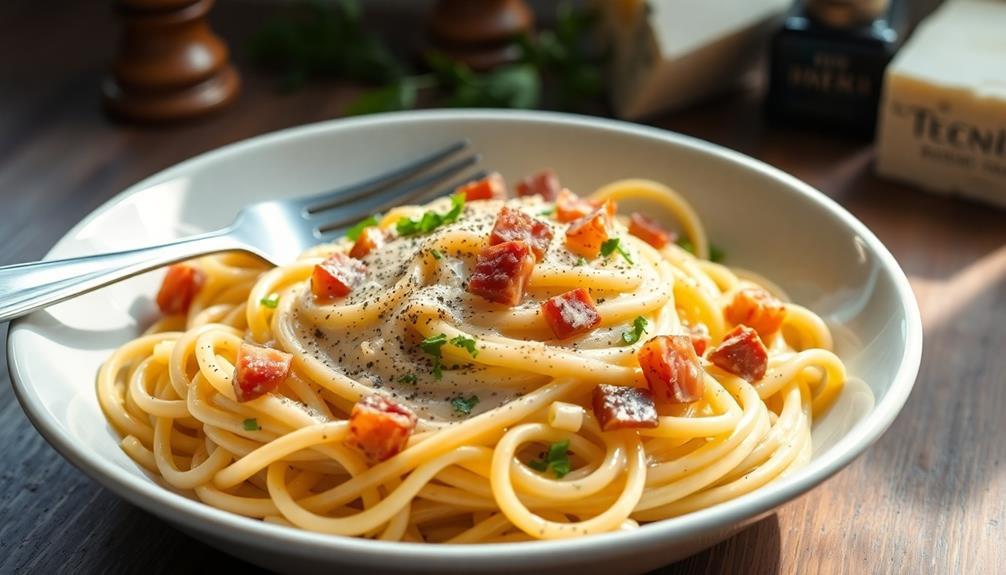Tagliatelle with ragù is a beloved Italian dish that'll warm your heart and tummy! This tasty meal combines long, flat pasta with a rich meat sauce. You'll love the mix of ground beef, veggies, and tomatoes, all simmered to perfection. It's a great choice for family dinners or special occasions. The sauce takes time to cook, but it's worth the wait! You can make extra and freeze it for later. Don't forget to top it with grated Parmigiano-Reggiano cheese for extra yum. Get ready to twirl your fork and dig in! There's so much more to discover about this classic comfort food. If you’re looking for something to pair with your tagliatelle with ragù, consider trying a traditional zabaglione recipe for dessert. This creamy, sweet custard is made with just a few simple ingredients – egg yolks, sugar, and sweet Marsala wine – and is the perfect way to end your Italian meal on a high note. It’s a timeless treat that’s sure to leave everyone at the table satisfied.
Key Takeaways
- Tagliatelle with Ragù is a traditional Italian dish originating from Emilia-Romagna, featuring fresh egg pasta and slow-cooked meat sauce.
- The ragù sauce typically includes ground beef, pancetta, tomatoes, vegetables, and red wine, simmered for 2-3 hours.
- Fresh tagliatelle pasta is preferred and should be cooked al dente before being tossed with the ragù sauce.
- The dish is often garnished with freshly grated Parmigiano-Reggiano cheese for enhanced flavor and presentation.
- Tagliatelle with Ragù is ideal for family dinners, celebrations, and impressing guests, with leftovers freezing well for future meals.
History
Tagliatelle with ragù traces its roots back to the culinary traditions of Bologna, Italy. This delicious pasta dish has been a favorite for centuries, and you'll love learning about its history!
- Origins:
- Created in the late 18th century
- Developed as a hearty meal for working-class families
- Became popular throughout the Emilia-Romagna region
- Evolution:
- Originally made with fresh egg pasta and slow-cooked meat sauce
- Recipe passed down through generations
- Adapted over time to include different ingredients and variations
You might be surprised to know that tagliatelle with ragù wasn't always served with tomatoes! The addition of tomatoes came later, as they became more widely available in Italy.
Today, you'll find many versions of this classic dish, but the traditional Bolognese recipe still reigns supreme.
When you sit down to enjoy a plate of tagliatelle with ragù, you're not just eating a delicious meal – you're also taking part in a rich culinary tradition.
It's a taste of history that brings families together and warms hearts with every bite!
Recipe
Tagliatelle with ragù is a classic Italian pasta dish that combines wide, flat noodles with a rich, meaty sauce. Originating from the Emilia-Romagna region of Italy, this hearty meal is a perfect choice for a comforting dinner or special occasion.
The key to a delicious ragù lies in slow-cooking the meat and vegetables to develop deep, complex flavors. While traditionally made with ground beef, many variations include a combination of meats such as pork, veal, or even pancetta. The sauce is simmered for hours, allowing the flavors to meld and intensify, resulting in a thick, savory coating for the pasta.
- 400g tagliatelle pasta
- 500g ground beef
- 200g pancetta, diced
- 1 onion, finely chopped
- 2 carrots, finely diced
- 2 celery stalks, finely diced
- 4 garlic cloves, minced
- 800g canned crushed tomatoes
- 1 cup red wine
- 1 cup beef broth
- 2 bay leaves
- 2 tbsp olive oil
- Salt and pepper to taste
- Grated Parmigiano-Reggiano cheese for serving
To prepare the ragù, start by heating olive oil in a large pot over medium heat. Add the pancetta and cook until crispy, then add the onion, carrots, celery, and garlic. Sauté until vegetables are softened.
Add the ground beef and cook until browned. Pour in the red wine and let it reduce by half. Add the crushed tomatoes, beef broth, and bay leaves. Simmer the sauce on low heat for 2-3 hours, stirring occasionally.
When the sauce is nearly ready, cook the tagliatelle in salted boiling water according to package instructions. Drain the pasta and toss it with the ragù. Serve hot with grated Parmigiano-Reggiano cheese on top.
For the best results, make the ragù a day in advance to allow the flavors to develop further. If the sauce becomes too thick during cooking, add a little water or broth to maintain the desired consistency. Remember to remove the bay leaves before serving.
For a richer flavor, you can add a splash of heavy cream to the sauce just before tossing it with the pasta. Leftover ragù can be frozen for up to 3 months and reheated for future meals.
Cooking Steps
Get ready to create a mouthwatering Italian classic!
You'll start by preparing fresh pasta dough and a savory meat sauce.
Then, you'll cook the pasta to perfection, combine it with the rich ragù, and top it off with grated Parmigiano-Reggiano for a truly delicious meal.
Step 1. Prepare Fresh Pasta Dough

Many pasta enthusiasts swear by making fresh pasta dough for their tagliatelle. It's a fun and rewarding process that'll make your meal extra special. Here's how you can prepare your own pasta dough:
Ingredients:
- 2 cups all-purpose flour
- 2 large eggs
- 1/2 teaspoon salt
- 1 tablespoon olive oil
- Water (if needed)
Steps:
- Pour the flour onto a clean surface and make a well in the center.
- Crack the eggs into the well and add salt and olive oil.
- Use a fork to beat the eggs and slowly incorporate the flour.
- Once it's too thick for the fork, use your hands to knead the dough.
- Keep kneading for about 10 minutes until it's smooth and elastic.
- If it's too dry, add a little water. If it's too sticky, add more flour.
- Form the dough into a ball and wrap it in plastic wrap.
- Let it rest at room temperature for 30 minutes.
Now you're ready to roll out and cut your tagliatelle! This fresh pasta will make your ragù even more delicious.
Step 2. Prepare the Meat Sauce
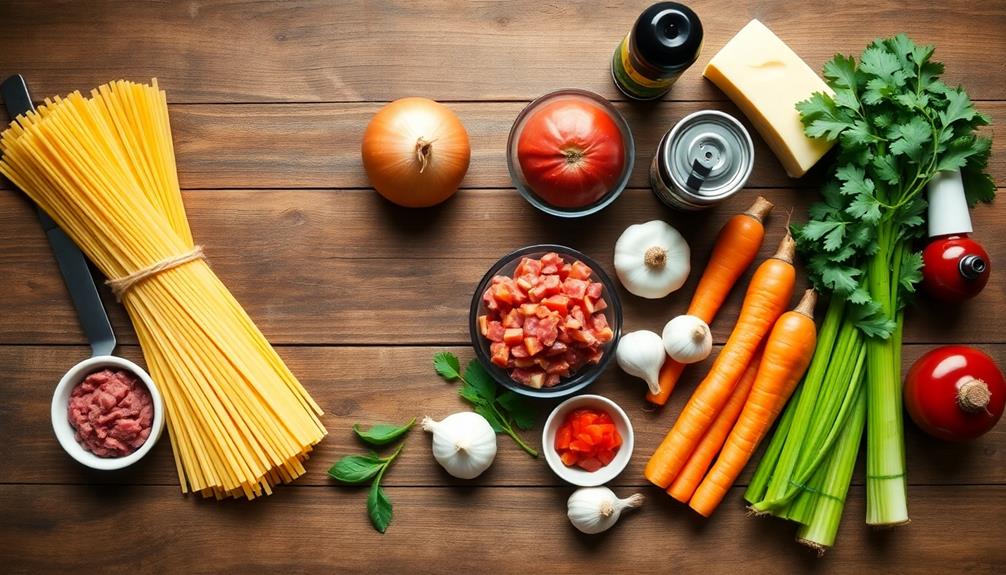
Now that you've prepared your pasta dough, it's time to focus on the heart of the dish: the ragù. This rich, meaty sauce is what makes tagliatelle al ragù so special. Let's get started!
Here's what you'll need:
- Ground beef and pork
- Onion, carrot, and celery
- Tomato paste and canned tomatoes
- Red wine
- Olive oil
- Salt and pepper
First, chop your veggies finely. Heat some olive oil in a big pot and add the veggies. Cook them until they're soft and smell yummy.
Next, add the meat and break it up with a wooden spoon. Let it cook until it's browned all over.
Now, pour in the red wine and let it bubble away. This adds a deep, tasty flavor to your sauce.
Once the wine has mostly evaporated, it's time for the tomatoes. Add the paste and canned tomatoes, stirring well.
Here comes the patience part: let your ragù simmer for at least 2 hours. Stir it now and then, and taste it to adjust the seasoning. The longer it cooks, the better it'll taste!
Step 3. Cook Pasta Until Al Dente
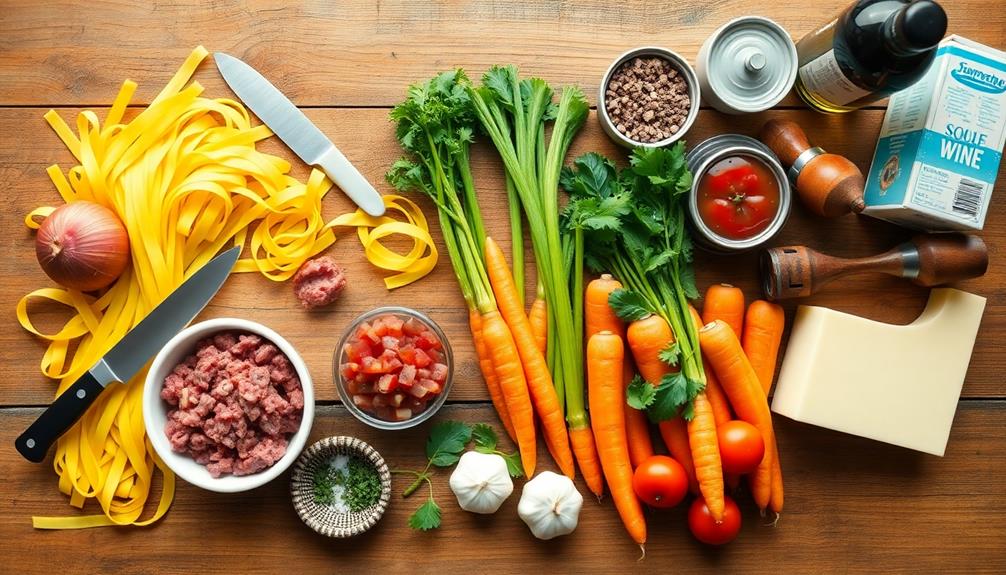
With the ragù simmering away, it's time to turn your attention to cooking the pasta. Fill a large pot with water, add a generous pinch of salt, and bring it to a rolling boil.
Once the water's bubbling, carefully add your tagliatelle.
Here's how to cook it perfectly:
- Stir the pasta gently to prevent sticking
- Set a timer for 1-2 minutes less than the package instructions
- Taste-test a strand when the timer goes off
You're aiming for "al dente" pasta, which means it's cooked but still firm when you bite it.
It'll have a slight resistance in the center – that's exactly what you want!
If it's not quite ready:
- Cook for another 30 seconds
- Test again
When it's just right:
- Drain the pasta quickly
- Don't rinse it – you want to keep the starchy coating
Step 4. Combine Pasta and Ragù
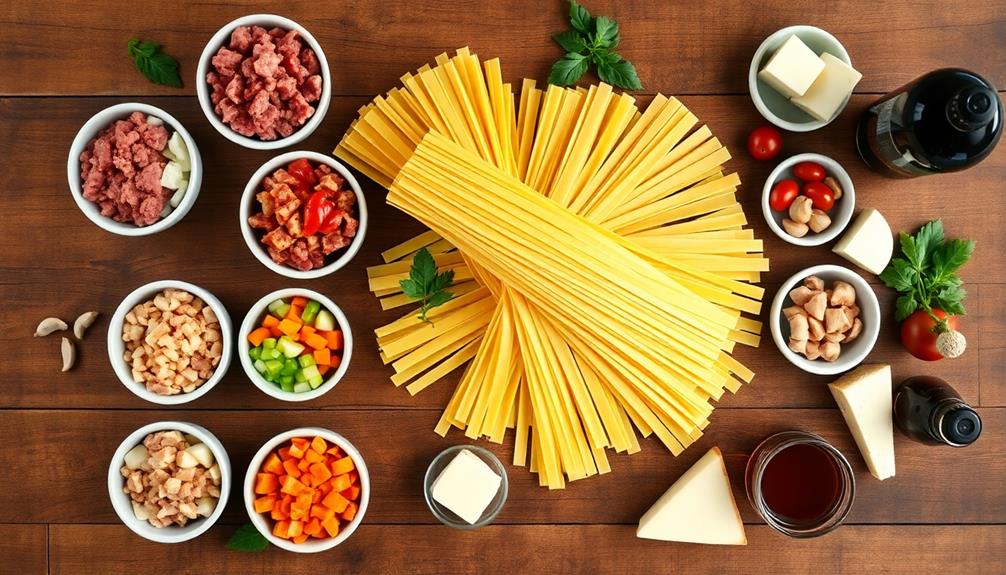
Your perfectly cooked tagliatelle is ready to meet its rich, flavorful companion. It's time to bring these two stars together in a delicious dance of taste and texture!
Here's how to combine your pasta and ragù:
- Drain the tagliatelle, but don't rinse it. You want to keep that starchy goodness!
- Return the pasta to the warm pot you cooked it in.
- Add a ladleful of the hot ragù to the pasta.
- Gently toss the pasta and sauce together. This helps the noodles soak up some of that yummy flavor.
- Now, add more ragù until you've got the perfect pasta-to-sauce ratio. Remember, you want each strand coated, not swimming!
- Keep tossing gently until everything's well mixed.
If your ragù has cooled down a bit, don't worry! Just put the pot back on low heat while you're mixing. This will warm everything up nicely.
Once you're happy with the mix, it's time to plate up and enjoy your homemade tagliatelle al ragù. Get ready for a burst of Italian flavors that'll make your taste buds dance with joy!
Step 5. Garnish With Grated Parmigiano-Reggiano
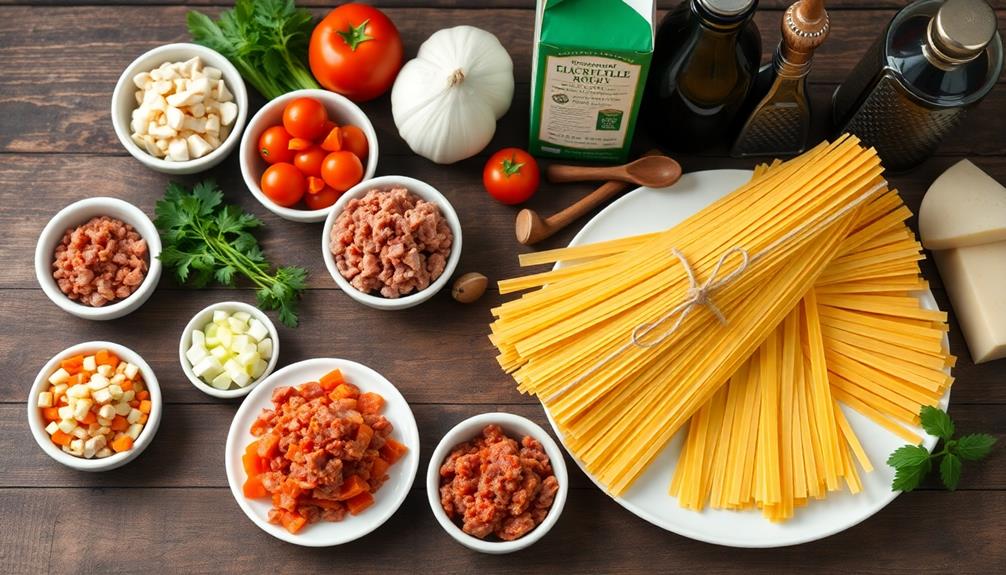
Crowning your tagliatelle al ragù, a sprinkle of freshly grated Parmigiano-Reggiano adds the perfect finishing touch. This cheese isn't just tasty; it's a special treat that makes your pasta dish even better!
Here's how to do it right:
- Get a block of real Parmigiano-Reggiano cheese
- Use a cheese grater with small holes
- Grate the cheese right before you're ready to eat
When you're ready to serve:
- Put the hot pasta and ragù on plates
- Hold the grater over each plate
- Grate a generous amount of cheese on top
- Let it melt a little from the heat of the pasta
The cheese will add a salty, nutty flavor that goes great with the rich ragù. It also makes your dish look fancy and inviting.
Kids and grown-ups alike will love the way it smells and tastes!
Final Thoughts
Tagliatelle with ragù stands out as a classic Italian dish that's worth mastering. It's a meal that brings families together and warms hearts with its rich flavors and comforting texture.
You'll find that making this dish becomes easier with practice, and soon you'll be whipping it up for special occasions or cozy weeknight dinners.
Remember these key points for the perfect tagliatelle with ragù:
- Use fresh pasta when possible
- Let the ragù simmer for hours to develop deep flavors
- Don't forget to salt your pasta water
- Always finish the pasta in the sauce
This dish is perfect for:
- Sunday family dinners
- Holiday gatherings
- Impressing dinner guests
- Meal prep for busy weeks
As you enjoy your creation, take a moment to appreciate the blend of flavors and the joy it brings to your table.
Tagliatelle with ragù isn't just food; it's a celebration of Italian culinary tradition that you can now share with your loved ones.
Frequently Asked Questions
Can Tagliatelle Al Ragù Be Made With Vegetarian Alternatives?
You can definitely make a vegetarian version of this dish. Try using plant-based meat alternatives, lentils, or mushrooms for a hearty texture. You'll still get a delicious, savory sauce to coat your pasta without the meat.
How Long Does Homemade Tagliatelle Al Ragù Sauce Keep in the Refrigerator?
You can keep homemade ragù sauce in the fridge for up to 4 days. It's best to store it in an airtight container. For longer storage, you can freeze it for up to 3 months.
What Wine Pairs Best With Tagliatelle Al Ragù?
You'll find that medium-bodied red wines pair best with this dish. Try a Sangiovese, Chianti, or Barbera. They'll complement the rich meat sauce without overpowering it. If you prefer white, a dry Pinot Grigio works well too.
Is Tagliatelle Al Ragù Suitable for Freezing and Reheating?
Yes, you can freeze and reheat this dish. It's best to freeze the sauce separately from the pasta. When reheating, thaw overnight in the fridge, then warm the sauce and cook fresh pasta for best results.
Are There Regional Variations of Tagliatelle Al Ragù Across Italy?
You'll find regional variations of this dish across Italy. In Bologna, they use a meat-based sauce, while in Tuscany, it's often made with wild boar. Some regions add cream or use different pasta shapes.
